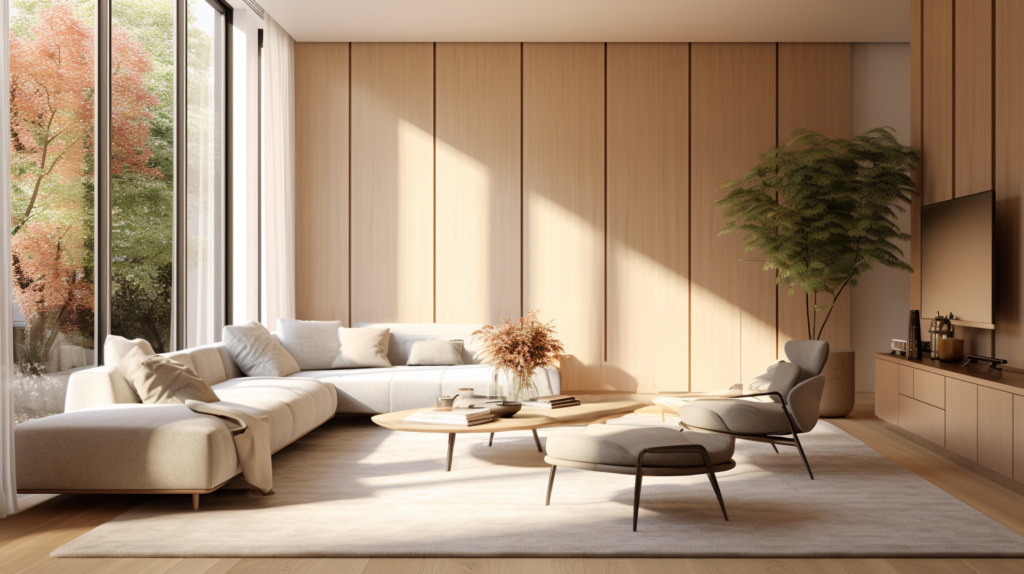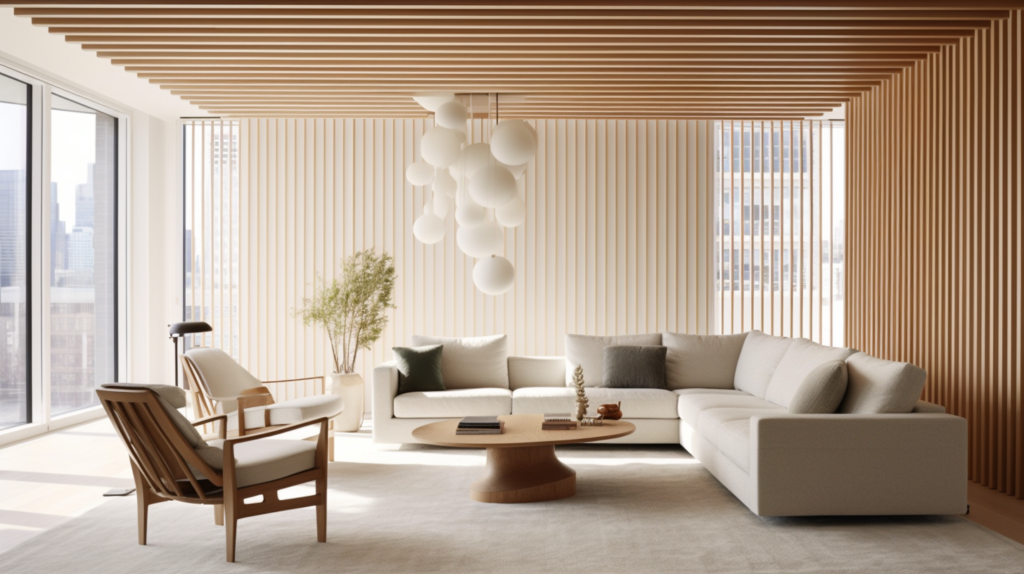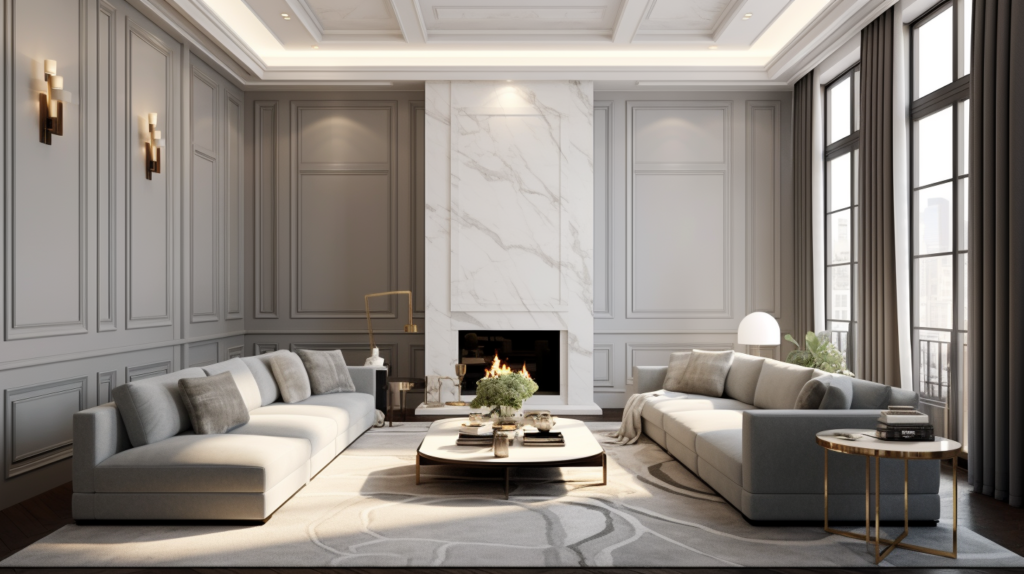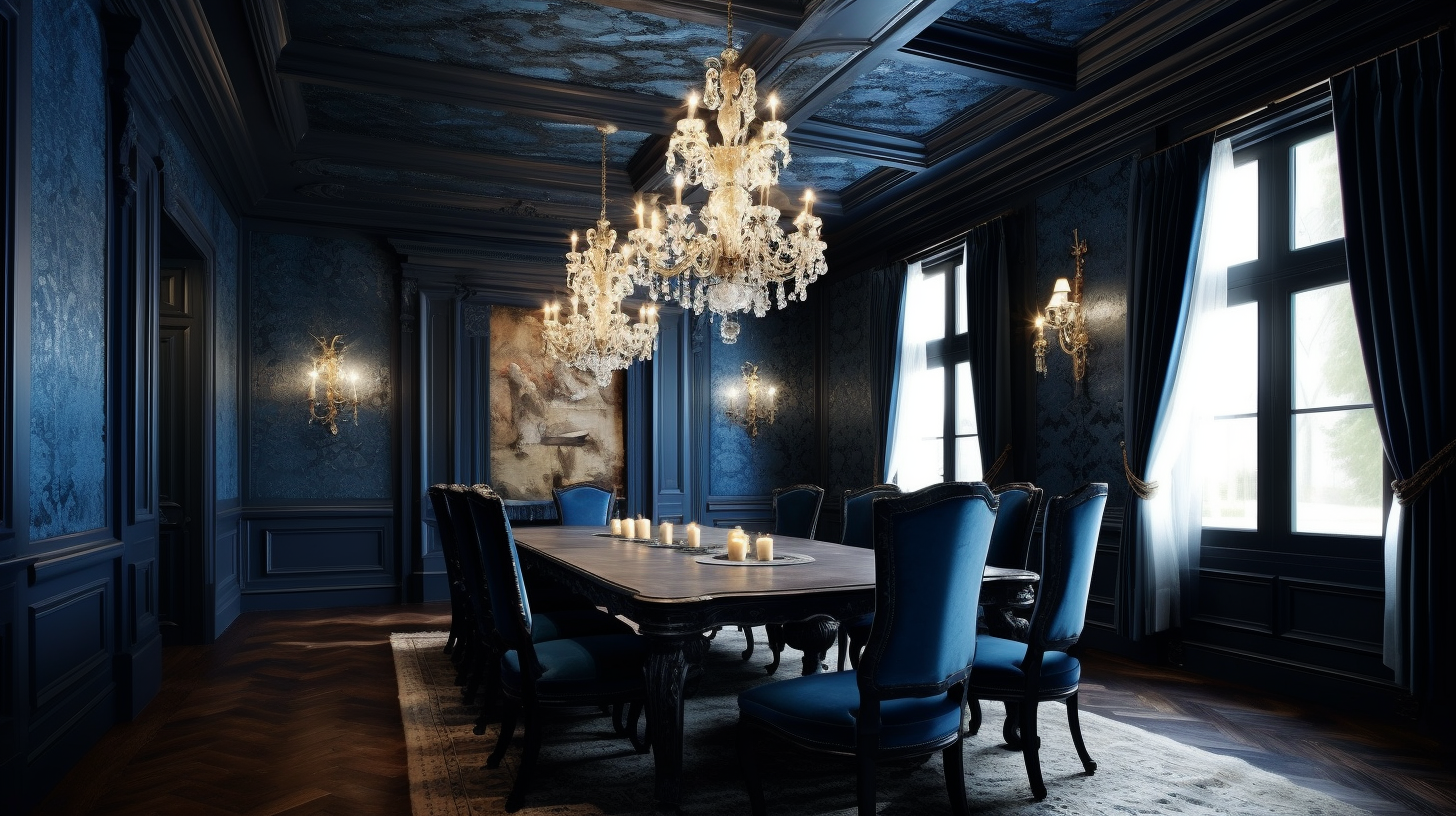Is ugly acoustic paneling ruining your interior design dreams? Those days are over.
Acoustic treatments have evolved far beyond their dreary stereotypes. With the right materials and planning, they can now seamlessly blend into any space.
In this post, we’ll shatter misconceptions about acoustic design and show how it can beautifully enhance function and aesthetics.
Let’s explore how acoustic technology has progressed to offer far more discrete and attractive options than the past.
Do acoustic panels have to look ugly?

There is a common myth in architecture and interior design that good acoustic design inherently means installing ugly foam panels or egg crate diffusers all over a space.
This belief comes from the fact that early acoustic treatments were very rudimentary and aesthetically displeasing.
They were usually either fiberglass panels covered in fabric or plastic geometric shapes protruding from walls. While these materials are effective at controlling sound, they impart a cold, sterile look.
Fortunately, acoustic technology and design options have advanced rapidly in recent years. There is now a wide range of beautiful, discreet acoustic treatment products available.
With careful planning, acoustic treatments can be subtly incorporated into a space in ways that enhance, rather than detract from, the overall aesthetic.
The key is considering acoustics early in the design process instead of as an afterthought.
Architects and interior designers need to shift perspectives and see acoustic planning as part of basic design needs, not at odds with visual goals.
There are countless examples of refined spaces with attractive acoustic designs that blend in seamlessly.
Concert halls, schools, offices, restaurants, and more have found ways to make acoustic treatments complement their style rather than compromise it.
With an expanded vision and the right approach, functionality and beauty do not need to be mutually exclusive when it comes to acoustic design.
How to make acoustic panels look good?

When selecting acoustic materials, it is important to prioritize performance and acoustic rating systems first rather than just choosing materials for aesthetics alone.
The most crucial specifications to understand are noise reduction coefficient (NRC) and sound absorption Coefficient (SAC).
NRC indicates the average sound-absorbing effectiveness of a material across various frequencies. SAC is the average of sound absorption coefficients at mid-range frequencies.
These metrics allow direct comparison of how well different materials absorb and control sound.
Once acoustic requirements are determined, choices can then be made to find visually appealing materials that also meet the necessary functional criteria.
There are now many options for materials like fabric, wood, metal, and plastic that look great while still effectively absorbing and diffusing sound.
What Are The Strategies for Aesthetic and Functional Materials?
Fabric wraps can mask more utilitarian materials like fiberglass and foam.
Strategically place these less attractive but highly functional materials out of sight lines, and cover them with more visually interesting outer layers.
Use a deliberate mix of different textures and materials like perforated wood, plastic, leather, acoustic plaster, and metal to create visual interest.
Custom-printed fabric or photographic wraps add color, patterns, and imagery to turn panels into artwork.
Irregular material shapes and asymmetrical arrangements make treatments more organic and natural.
Wall hangings and drapery disguise absorber panels further. There are endless possibilities to balance aesthetics and acoustic performance with creative solutions.
It is also advisable to bring in an interior designer or architect specializing in acoustics early in the process. Their expertise steadies the crucial balance between form and function.
Consult Acoustic Specialists
Acousticians know building codes and requirements for critical listening environments like theaters and studios. They recommend constructions, isolations, and equipment needed in sensitive spaces.
Their experience also exposes them to niche acoustic products and fabrication techniques beyond the mainstream public’s knowledge.
With the right expertise guiding material and design choices, acoustic treatments seamlessly blend into any space beautifully.
When should I hire an acoustic consultant?

For spaces like recording studios and theaters where acoustics are absolutely critical, it is highly recommended to bring in an expert acoustician early in the design process.
They can help set specific acoustic requirements for the space right from the start.
This allows them to thoughtfully plan acoustic treatments and design custom solutions tailored to the space. Trying to retrofit acoustic corrections after construction often leads to compromised results.
The acoustician can identify potential issues and advise specialized constructions needed for ideal sound control.
Acoustic Needs in Commercial Spaces
Commercial projects with complex acoustic needs also benefit greatly from an experienced professional. Performance venues, open-plan offices, restaurants, and other noisy spaces demand careful analysis.
Acoustic consultants have specialized modeling software and diagnostics equipment for in-depth evaluation. This allows them to analyze acoustic issues far more precisely than laypeople.
They can diagnose problems through sound spectrum analysis and reverberation time calculations. Noisy areas or bad echo can be pinpointed so targeted solutions are applied efficiently.
Fixing Acoustic Issues in Existing Buildings
Even existing buildings with significant acoustic problems can be dramatically improved by bringing in a consultant. Their testing reveals where sound leaks or gets trapped.
Then custom treatments can remedy problems like excessive bleed between rooms or ambient noise that hinders concentration. The right expert fixes quality issues undetectable to untrained ears.
Acousticians simply know how to correctly apply acoustic principles in ways the average person does not. Their deeper understanding comes from both classroom education and years of field experience.
They are familiar with a wider range of commercial acoustic products and fabrication techniques, some not available to the general public.
There are so many variables that optimal results require specialist expertise. It is well worth hiring professionals for the best acoustic comfort and functionality. Examples of good-looking acoustic design
There are countless real-world examples of refined acoustic design that integrate beautifully into all types of spaces.
Concert halls use carefully calculated curved walls and ceilings to distribute sound waves throughout the room.
Classrooms blend sound diffusers into ceiling tiles and wall panels so they disappear into the architecture. This facilitates clear speech without the visual clutter of obvious protruding panels.
Acoustic Design in Commercial Interiors
Modern open-plan offices use bold color blocks and custom prints to dampen noise and add lively flair. Acoustic fabric comes in all colors and patterns to match any decor.
Corporate environments hide thick sound-absorbing drapes behind elegant half-walls or disguise them as space dividers.
Restaurants layer acoustic fabric behind trendy perforated wood or metal to dampen loud dining spaces. Even wall art, photographs, and hangings can be printed on acoustic canvases.
Residential and Specialty Spaces
Lobbies feature custom printed absorber panels mixed artfully with decorative items so they blend rather than stand out.
Home theaters disguise thick sound-absorbing drapes as elegant curtains and wall panels as textured wallpaper.
Recording studios carefully construct special nonparallel walls and irregular rooms to prevent flutter echo and sound distortion.
Ceilings integrate sound-diffusing metal baffles and panels as architectural features rather than obvious add-ons.
Advanced Acoustic Products and Planning
Advances in material engineering now allow combination panels that provide broadband absorption and diffusion in a single discrete fixture.
Manufacturers offer custom acoustic products in just about any shape, color, print, and finish desired. With some creative thinking, acoustic treatments do not have to be an ugly afterthought.
If cared for appropriately, they can enhance a space with elegant and seamless design elements. The myth that acoustics means compromising aesthetics is simply outdated.
With today’s products and proper planning, it is entirely possible to blend acoustic function and beauty gracefully.
The previous sections introduced the unfortunate myth that acoustic design must be ugly.
But as discussed, treatments can actually be thoughtfully incorporated to complement and enhance a space beautifully.
Specific strategies for balancing aesthetics and acoustic performance in material selection were covered.
Now we have gone over situations where hiring a professional acoustician pays off tremendously for spaces where acoustics are critical.
Finally, real-world examples illustrated the endless possibilities for attractive acoustic design. With the right approach and expertise, there is no need to sacrifice beauty for acoustic comfort and functionality.
Conclusion
Acoustic design has come a long way from the unattractive stereotypes of the past.
With a greater understanding of principles and advances in materials, treatments can now elegantly blend form and function.
The myth that acoustics must look ugly has been shattered by countless real-world examples of refined spaces with seamless treatments.
Armed with creativity and acoustic expertise, design professionals can craft beautiful, comfortable soundscapes.
There is simply no need to sacrifice aesthetics for acoustic performance anymore. Careful planning and selection of complementary finishes turn acoustic solutions into design features.
Just as lighting and furnishings are considered, acoustics should be an integral part of any space’s ambiance.
With the strategies and perspectives covered here, the possibilities for graceful acoustic design are endless.
